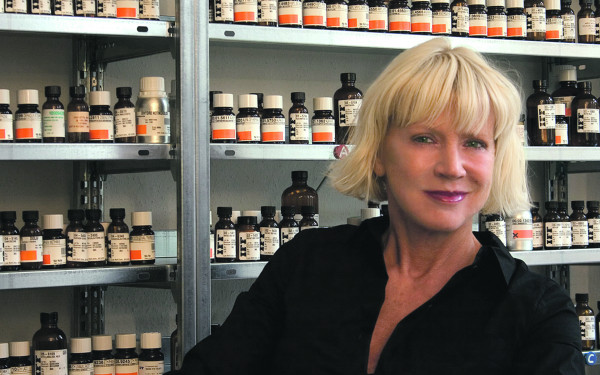The Organism of Robots
Multimedia Artists Create Kinetic Installation Exploring Robotics and Ecosystems
Somewhere between fact and fiction, Eastern Bloc Gallery revisits the theme of robots and drones for the exhibition Robotis Personae. Presenting a binary and complementary perspective by artists Sofian Audry, Samuel St-Aubin, Stephen Kelly and Beatriz Herrera, the gallery examines the paradoxes existing between the machine and the human environment.
Describing herself as a “hermitic luddite who loves robots,” Chilean-born mixed media artist Beatriz Herrera is based in Montreal and graduated from Concordia’s Master of Fine Arts program a year and a half ago.
Working with organic and simple mechanisms, Herrera creates in_ Humo, Leche y Miel_ (Smoke, Milk and Honey) a kinetic installation in which she plays on the association of opposing elements, mixing the organic and the robotic; the automatic and the uncalculated; and the spontaneous along with the pre-programmed.
St-Aubin, Audry and Kelly present a different take on robotics with the installation Vessels : Intro, an exhibit composed of a multitude of robots swimming among other machines. The piece reflects on the role of collective behaviour and what this specific observation says about a certain environment. Using diverging ideas and visions, Herrera explained they still shared similar preoccupations.
“We’re both trying to explore emergence, how small random movements and decisions really create a whole world,” she said. “Also, we’re all trying to experiment with expectations of how artists’ robots might work: where can we set up the work? How can we create interventions in the world? How to take the robots outside the gallery?
“Ironically, I’ve realized that for me, if I ever want to safely take my work out into the world, the gallery is absolutely necessary as a space of experimentation.”
In an empty room of the Eastern Bloc gallery, Walker, Porcupine, The Blob and The Brain—the names given to the robots on display—interact with each other and move around the space they share. On the walls of the room, various types of sketches, mock-ups and drawings present the different steps of the conceptualization and creation of these metallic creatures.
Every robot Herrera created carries its own distinctive characteristics. Walker has legs that kick, Porcupine has a spiky allure, The Blob was built with misshapen wheels forcing it to circulate in unsteady jerks while The Brain spins around and around in its rubber, metal and paper structure.
Focusing on behavioural patterns, Herrera plays largely with scale and differences in robot size – her largest piece being close to seven feet long while the smallest is only two feet long. She looks at the ways in which their irregular forms operate and influence the way they move, crash into each other or chase one another.
Deliberately exposing the hand-made nature of her robots, Herrera aims to critique certain concepts of efficiency and technology in our culture. Building the robots from scratch, her approach is not one of a mechanical engineer trying to build the perfect machine but one of an artist exploring and experimenting with that discipline.
Through the process of creating these machines, her observations underline the limits of human control over robots. Once they are created, Herrera explains, small imperfections come into play and the way the robots are going to move becomes unpredictable.
Could robots have an instinct of their own? The title of the piece_ Humo, Leche y Miel_, she explained, made sense to her in her desire to move away from typical interactive installations. The robots are showcased in the space as having a life of their own, independent from the spectator’s point of view. In a playful and subtle take on robotics, her installation is an open-ended question on the increasingly consequent space occupied by robots and drones in our environment.
“Robots fascinate me most of all because they are a physical presences among us. It’s not an invisible technology, it’s not tiny, it’s everything from rumbas to military drones, to robotic field medics and nannies,” said Herrera.
Part of what motivated her to work with the world of robots and machines was the realization of the omnipresence of technology in our culture, how deeply entrenched it is in our everyday lives and how little we truly understand it.
“It really speaks of a complete disconnect with our world, not just technology, but everything from our clothes, shit, garbage, tax money. Where does any of it go? To a great degree my art practice is about a series of small gestures to attempt to understand the context of the world that’s around us right now,” said Herrera.
For her next project, Herrera will also be working with robots and more precisely on a triptych of talking, recording and story-telling robots. Interested in the emotional responses triggered by the contact with physical machines, most of her research relies on people’s testimonies, stories about robots, monologues, jokes and “neurotic, fearful, nervous, hopeful, pedantic little shorts,” Herrera concluded.
ROBOTIS PERSONAE // Jan 22. – Feb. 11 // Eastern Bloc Gallery // Opening hours: Tuesday – Sunday, 12 p.m. – 5 p.m.

_900_282_90.jpg)
_600_832_s.png)

_600_375_90_s_c1.jpg)
_600_375_90_s_c1.jpg)

_600_375_90_s_c1.jpg)